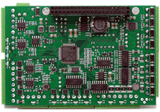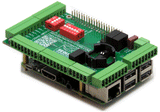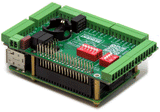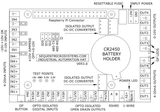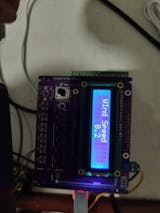NEW VERSION IN STOCK WITH MAJOR ENHANCEMENTS :
-
Analog inputs resolution increased from 12 bits to 16 bits
-
Software controlled switches for analog input range selection
- Improved signal levels on RS485 port
-
EMC radiation reduced with filters on DC-DC converters
FEATURES
- Industrial Automation 8-Layer Stackable HAT for Raspberry Pi
- Wide range 12-30V power supply provides also 5V/4A to Raspberry Pi
- Four Optically Isolated Digital Inputs with status LEDs
- Four 0-10V or ±10V 16 bit Analog Inputs, 250Hz sample rate
- Four Optically Isolated 4-20mA 12 bit Inputs, 1KHz sample rate
- Four Optically Isolated Open Drain Outputs, 24V/4A peak
- Four 0-10V 14 bit Analog Outputs
- Four 4-20mA 14 bit Analog Outputs with load interruption detection
- Four General Purpose software controlled LEDs
- TVS Protection on all Inputs for safeguarding industrial Raspberry Pi systems
- RS485 Port
- 1-Wire Interface
- On Board Hardware Watchdog
- On Board Fuse
- Real Time Clock With CR2032 Battery Backup (battery not included)
- Pluggable Connectors 26-16 AWG wires
- Eight Level Stackable
- Uses only I2C port, all GPIO pins available
- Works with any Raspberry Pi from ZERO to 5
- ECCN Code EAR99
- Command Line
- Python Library
- Node-Red nodes
- MODBUS interface
- CODESYS Driver
- OpenPLC module
- Home Assistant Integration
- Perfect for industrial Raspberry Pi projects and applications
- Industrial Automation 8-Layer Stackable HAT for Raspberry Pi
DESCRIPTION
INDUSTRIAL AUTOMATION for RASPBERRY PI
Ideal start for complex Industrial Automation Projects.
Read four sensors with optically isolated, 12 bit 4-20mA inputs, and control four actuators using 4-20mA outputs.
Read four sensors with 16 bit 0-10V or ±10V inputs, and control four actuators with 14 bit PWM 0-10V outputs.
Software select analog inputs for 0-10V or ±10V (no jumpers or DIP switches)
Drive four heavy-duty 24VDC/4A loads with MOSFET outputs.
Read four optically isolated digital inputs, 0-24V.
Program four LEDs to display the state of any digital or analog input or output.
Keep time indefinitely even during a power failure using the Real-Time Clock with battery backup.
Activate the hardware watchdog to monitor and power cycle the industrial Raspberry Pi in case of software lockup.
TVS diodes on all inputs protect the card for external ESD.
Onboard resettable fuse protects it from accidental shorts.
DRIVING ADDITIONAL LOADS
Heavy loads of up to 8A and 250VAC can be driven by adding one or more 4-RELAYS HATs. High DC loads of up to 10A and 250V, with fast response time and unlimited endurance can be driven by adding one or more 8-MOSFETS cards.
COMMUNICATION
Connect the card to other Industrial Automation Systems using RS485/Modbus and 1-Wire communication ports. The RS485 can be driven either from the local processor through I2C commands, or directly from the Raspberry Pi using the dedicated pins on the GPIO connector, which are routed on the Industrial board to the RS485 driver.
NEW: 1-Wire Interface. Read DS18B20 Temperature sensor using the 1-Wire interface.
COMPATIBILITY
The Industrial Raspberry Pi Automation Cards share the I2C bus using only two of the Raspberry Pi’s GPIO pins to manage all eight cards. This feature leaves the remaining 24 GPIOs available for the user. It is compatible with all Raspberry Pi versions from Zero to 5 and has all the necessary I/Os for your Industrial Automation projects.
POWER REQUIREMENTS
The Industrial Automation card needs an external 12 to 30VDC power supply and has to be powered from it's own pluggable connector. The card supplies 5V and up to 3A to the Raspberry Pi on the GPIO bus. A local 3.3V regulator powers the rest of the circuitry. The card needs 50mA to operate.
PLUGGABLE CONNECTORS
All the IO's are connected to heavy duty (8A), 3.5mm pitch pluggable connectors which make field wiring very convenient for installation and debugging.
STACKING MULTIPLE CARDS
Up to eight Industrial Automation cards can be stacked on your Raspberry Pi. Cards can be installed in any order. Each card is identified by jumpers you install to indicate the level in the stack.

For your convenience, two jumpers are provided with each card.
CARD LAYOUT

ELECTRICAL SPECIFICATIONS
- Power supply: 3.5mm Pluggable Connector, 12-30VDC/1A
- Power consumption: 50mA @ 24V
- On board resettable fuse: 2.5A
-
0-10V Inputs:
- Maximum Input Voltage: 12V
- Input Impedance: 20KΩ
- Resolution: 16 bits
- Sample rate: 250Hz
- Full scale linearity: 0.15%
- 0-10V Outputs:
- Minimum Output Load: 1KΩ
- Resolution: 14 bits
- Full scale linearity: 0.1%
- 4-20mA Inputs:
- Sample rate: 675 Hz.
- Input impedance: 150Ω
- Resolution: 12 bits
- 4-20mA Outputs:
- Resistive load: Maximum 1 KΩ @ 24V external voltage
- Maximum external voltage: 24V
- Resolution: 14 bits
- Open Drain Outputs:
- Maximum Output Current: 4A
- Maximum Output Voltage: 24V
MECHANICAL SPECIFICATIONS

4-20mA CURRENT LOOPS
Since 4-20mA current loops are optically isolated from the system ground, they can be used with isolated on non-isolated, 2, 3 or 4 wire transmitters. In all cases you need to provide external power supply (up to 24VDC).
In the following diagrams we used the following notation:
1: External 4-20mA Transmitter
2: Industrial Automation Board
3: External Power Supply
4: External 4-20mA Receiver
Typical configuration of the input loops:

Case 1: Two wire transmitter, shared ground.

Case 2: Three wire transmitter, shared ground.

Case 3: Four wire transmitter, isolated ground.
The 4-20mA outputs are driven by Open Drain MOSFETS with a common ground. Connect your 4-20mA receiver as shown in the following diagram:
Q1: What Features Does The Industrial Automation V3 8-Layer Stackable HAT For Raspberry Pi by Sequent Microsystems Offer?
The Industrial Automation V4 HAT for Raspberry Pi by Sequent Microsystems features a wide 12-30V power supply, optically isolated digital inputs and outputs,16 bit 0-10V inputs, 14 bit 0-10V outputs, 4-20mA analog inputs and outputs, RS485 port, 1-Wire interface, hardware watchdog, and real-time clock with battery backup, making it ideal for industrial raspberry pi applications.
Q2: How Can I Use Raspberry Pi HAT For Industrial Automation?
This Raspberry Pi HAT supports industrial automation with its robust I/O options, including 0-10V and ±10V analog inputs, 4-20mA inputs, optically isolated digital I/Os, and a stackable design, enhancing raspberry pi industrial capabilities.
Q3: Can The Raspberry Pi PLC HAT Be Used For Precision Control In Industrial Applications?
Yes, the Sequent Microsystems Raspberry Pi PLC HAT can be used for precision control with its 250 Hz sample rate for analog inputs, optically isolated 4-20mA inputs, 4-20mA outputs with load interruption detection, making it ideal for raspberry pi industrial applications
Q4: What Makes The Sequent Microsystems Raspberry Pi Automation HAT Suitable For Critical Industrial Tasks?
The Sequent Microsystems Raspberry Pi Automation HAT is suitable for critical tasks due to its hardware watchdog, real-time clock, and RS485/Modbus communication, providing reliable raspberry pi automation hat solutions for various industrial environments.
Q5: Is The Industrial Raspberry Pi HAT Compatible With All Raspberry Pi Models?
Yes, the Industrial Raspberry Pi HAT is compatible with all Raspberry Pi models from ZERO to 5, ensuring versatile use in industrial raspberry pi applications and easy integration across different Raspberry Pi versions.
DOWNLOADS
Industrial Automation Card Downloads
SOFTWARE
SOFTWARE INTERFACES
You can write your control system in C, C++, PERL , of the language of your choice using the Command Line system or Python Drivers. Or you can implement everything in Node-Red and display it in the browser using the Node-Red node.
FIELD CALIBRATION
All the analog inputs and outputs are calibrated at the factory, but firmware commands permit the user to re-calibrate the board, or to calibrate it to better precision. All inputs and outputs are calibrated in two points; select the two points as close to possible to the two ends of scale. To calibrate the inputs, you must provide analog signals. (Example: to calibrate 4-20mA inputs, you must provide a 4mA and 20mA current source). To calibrate the outputs, you must issue a command to set the output to a desired value, measure the result and issue the calibration command to store the value.
WATCHDOG
The Industrial Automation card contains a built-in hardware watchdog which will guarantee that your mission-critical project will recover and continue running even if Raspberry Pi software hangs up. After power up the watchdog is disabled, and becomes active after it receives the first reset.
The default timeout is 120 seconds. Once activated, if it does not receive a subsequent reset from Raspberry Pi within 2 minutes, the watchdog cuts the power and restores it after 10 seconds.
Raspberry Pi needs to issue a reset command on the I2C port before the timer on the watchdog expires. The timer period after power up and the active timer period can be set from the command line. The number of resets is stored in flash and can be accessed or cleared from the command line. All the watchdog commands are described by the online help function.
RS485/MODBUS Communication
The card contains a standard RS485 transceiver which can be accessed both by the local processor and by Raspberry Pi. The desired configuration is set from three bypass jumpers on configuration connector J3.

If jumpers are installed, Raspberry Pi can communicate with any device with an RS485 interface implementing any protocol it needs, Modbus, Profibus, PTZ control, etc. In this configuration the card is a passive bridge which implements only the hardware levels required by the RS485 protocol. To use this configuration, you need to tell the local processor to release control of the RS485 bus:
~$ megaind [0] rs485wr 0 0 0 0 0
If jumpers are removed, the card operates as MODBUS slave and implements the MODBUS RTU protocol. Any MODBUS master can access all the card's inputs, and set all the outputs using standard MODBUS commands. A detailed list of commands implemented can be found on GitHub.
In both configurations the local processor needs to be instructed to release (jumpers installed) or control (jumpers removed) the RS485 signals. See the command line online help for further information.
FIRMWARE UPDATE
The card firmware can be updated in the field by running a command. The update is made with the latest firmware version located on our servers. More instructions about the process can be found on GitHub. Please make sure there is no process, like Node-Red or python scripts, that tries to access the card during the update process.
ACCESSORIES
DIN-RAIL MOUNTING
The Industrial Automation card can be installed parallel on a DIN-Rail using the DIN-Rail Kit Type 1, or perpendicular using the DIN-Rail Kit Type 2.
SMART FAN
The Smart Fan provides a stackable cooling solution for Raspberry Pi. Its on-board processor powers the fan just enough to maintain the preset temperature of the Pi.
YOUR KIT
When you purchase the Industrial Automation Card you will receive the following items:
1. Industrial Automation Stackable Card for Raspberry Pi

2. Mounting Hardware
- Four M2.5x18mm male-female brass standoffs
- Four M2.5x5mm brass screws
- Four M2.5 brass nuts

3. Connector Plugs for all Inputs and Outputs
- Six 8-pin female mating connector plugs for IO's
-
One 5-pin female mating connector plug for RS465 and 1-Wire ports.
-
One 2-pin female mating connector plug for power.

QUICK START
- Plug your card on top of your Raspberry Pi and power up the system
- Enable I2C communication on Raspberry Pi using raspi-config.
- Install the software from github.com:
-
- ~$ git clone https://github.com/SequentMicrosystems/megaind-rpi.git
- ~$ cd /home/pi/megaind-rpi
- ~/megaind-rpi$ sudo make install
- ~/megaind-rpi$ megaind
The program will respond with a list of available commands.




















